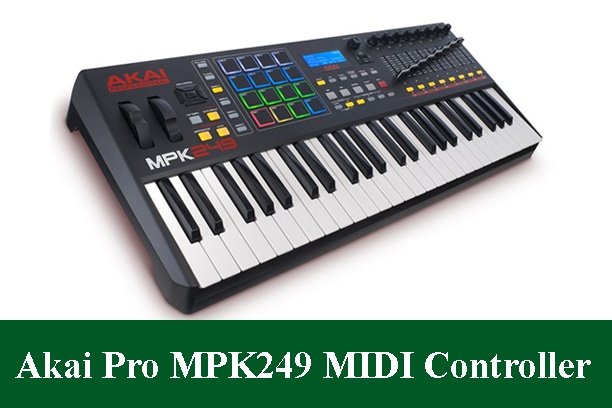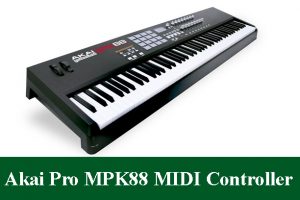Akai Professional MPK249 Performance Keyboard Controller Review (Updated)
Akai has been making production apparatuses, drum machines, and keyboards throughout the previous quite a few years. They’re the seasoned veterans that performers have depended on consistently, continually putting out consistently professional-quality rigging. Be that as it may, the one of a kind thing about Akai is that in addition to the fact that they make professional-review outfit, they make extraordinary gear for artists that are simply beginning on their execution and production vocations.
In view of the majority of this, I as of late demoed Akai’s midi controller, the MPK249. Give me a chance to begin this survey by saying that Akai makes some great stuff, and the expectations are in every case high when they turn out with another controller or keyboard.
Akai is one of the organizations that has transitioned extremely well from the old methods for the music business and into the digital age, where electronic writing computer programs is in about each pop song, and almost every sort is utilizing types of digital, electronic examples and sounds in their very own music. Knowing this, I expect beneficial things from Akai.
Their MPK arrangement has been around for a couple of years now, and I used to claim a littler version (the MPK smaller than usual) of the keyboard I’m going to survey. I adored the MPK smaller than normal and I lament giving a companion “a chance to get” it, however too bad I may never observe it again.
In any case, subsequent to demoing this instrument, I’m genuinely considering grabbing the MPK249’s currently, in light of the fact that I was entirely satisfied with it.
Understanding MIDI Controllers
Initially, perceive this isn’t a digital piano. It is a midi controller, or MIDI keyboard.
What’s the distinction?
All things considered, a MIDI controller does not have any sounds inside, and can’t make sound on its own. You may feel that is truly faltering, however under the watchful eye of you judge, you should realize that a ton of professionals utilize midi keyboards in their studios.
Why?
Since MIDI keyboards are intended to be utilized with PC programming programs called DAWs or Digital Audio Workstations, (for example, Pro Tools, Logic, or Ableton to give some examples) so as to control the digital, virtual sounds. DAWs are utilized for everything from music production and sound design, to blending and acing, to live execution. DAWs are extraordinary approaches to figure out how to make music, but on the other hand they’re the standard for account music. Everyone who is not kidding about music will experience a DAW sooner or later.
Presently, in light of the fact that DAWs are costly, midi controllers are commonly somewhat less expensive than digital piano keyboards. Normal keyboards more often than not have speakers, an option to choose diverse preset sounds, connections for playing on outside speakers and amps, and some of the time a little chronicle function. The DAW is fundamentally a place to have the majority of this digitally, using the PC. MIDI keyboards just control the functions you need to do using the buttons on the keyboard and the keys themselves.
Target Market
The Akai MPK249 has a ton of extraordinary features, however it flourishes in two or three distinctive ways. The question is whether this MIDI keyboard is ideal for you, however.
As we take a gander at all of the diverse features, we’ll attempt to consider who Akai is focusing with this machine. Is the MPK249 for tenderfoots, professionals, or some place in the middle?
Finally, it’s significant (particularly in the event that you are a parent) that midi keyboards, while they look like little pianos for novices, are not by and large gone for piano understudies by any means, explicitly those that are youngsters.
The truth of the matter is that youngsters most likely won’t have any desire to invest the energy to figure out how a complex digital sound workstation functions, since DAWs are devices utilized by professionals.
DAWs are intended for the technically and sonically clever, and regularly require long periods of work to ace. For example, I’ve been utilizing Abelton Live for around four or five years now, and there are things despite everything I don’t think about it, and I’m a grown-up who spends something like fifteen to twenty hours per week on music production and composing.
Accordingly, in light of the fact that MIDI controllers are intended to be utilized with DAWs, they’re likely best for the individuals who are somewhat more established and will put in the work to have the capacity to utilize one effectively.
Overview
Akai’s MIDI controllers are quite extraordinary as a rule, in light of my experience, so I was anxious to try out the MPK249. It’s somewhat fancier than the MPK smaller than usual, due to some degree to the more prominent number of keys, yet additionally to a great extent because of the way that there are more buttons, more cushions, and a few wheels on the left-hand side of the keyboard.
Be that as it may, it adheres to its work of art, square shaped MPK design, which resembles plastic, yet it’s sturdy enough to withstand a ton of transportability. I lifted it up to perceive how it would feel to convey it into a studio or to a gig. It’s lighter than it looks (12.6 pounds, to be exact), which is dependably a decent sign, and it appears as though it would deal with movement entirely well.
Some midi keyboards feel a bit excessively wobbly yet this one seems to be genuinely tough given its size and weight.
Akai is well known for their three letter abbreviations when naming instruments and production apparatuses. Akai made its name when hip-jump makers during the 80s began utilizing the incredible MPC drum machine.
This blast bap style drum sampler is responsible for the absolute most amazing hip-jump and rap exhibitions at any point recorded. As a result of its usability, capacity to change tests, and extraordinary stock drums, the MPC was the standard for drum machines alongside the more electronic simple Roland TR-808 drum machine (still responsible for such a large number of iconic drum sounds today).
The MPK is a reference to the MPC, more as a production instrument than a genuine drum machine. Nonetheless, I think there are couple of tributes to the MPC that you can discover on the MPK249.
For example, Akai has dependably been astonishing with drum cushions. The drum cushions on the MPK can be found in a network on the essence of the keyboard, in a gathering of 16 cushions. Normally, I needed to play around with them. They feel delicate, yet they are speed touchy and simple to press. You can squeeze more than one cushion at the same time to inspire different sounds to trigger without a moment’s delay.
Presently, when you originally set up your Akai MPK249, squeezing the cushions is equivalent to squeezing a portion of the keys. They’ll play whatever your keyboard is mapped to. This implies you’ll need to delineate cushions to another sound independently. You can do this, obviously, yet I figured you should need to think about it on the off chance that you took a stab at hitting the cushions yet could only play the sound mapped to the keys.
Beside the cushions are a progression of bank controls. This enables you to look through banks, which are sets you can change to. Consider it like an octave button on a synthesizer, which changes the octave, yet despite everything you play the equivalent keys. The bank buttons do a similar thing, only as opposed to changing the octave, they change the scope of sounds you can play with the cushions.
I adore the shades of the cushions, and how they’re effectively discernable from one another. I wish Novation would take a prompt from Akai for their cushions and make the coloration on their Launchpads and midi controllers somewhat more clear.
The DAW Control Keypad
This thing is so valuable. It enables you to look through things on the PC screen while never touching the mouse. You can delineate to do anything you desire, however it’s ideal for looking through synth presets. Alongside the keypad is a beat tap, a note repeater, an arpeggiator, and a lock. The arpeggiator enables you to play a grouping of notes, and the hook essentially holds the arrangement set up so you can tweak it without holding down the keys.
The focal point of the substance of the midi keyboard is the place things get somewhat confused. As I would see it, this may be to the weakness of the MPK249. The screen is clear and simple to peruse, and the information displayed on the screen can be filtered through utilizing the parchment wheel to one side.
There are likewise a few DAW controls underneath the screen, including preset and program changes, reviewing and circling, which you need to allocate to your DAW’s seeing and circling functions, and in addition some forward and in reverse playback buttons, a stop and play, and a record button.
These are altogether helpful, yet you need to set aside the opportunity to set them up in case you’re willing to utilize them. You can likewise control the octave and the banks on the buttons underneath.
Honestly, I feel like many individuals who make music never utilize any of the features included beneath the screen. Individuals for the most part utilize MIDI controllers for the keys, the cushions, the handles and faders, and the wheels. Beyond that, you can control everything through your composing keyboard, and most DAWs even have hotkeys to make it less demanding.
Besides, in case you’re accustomed to utilizing your composing keyboard as of now, there is minimal possibility you’ll change. So while the buttons beneath the screen are an incredible option to have in the event that you need it, I don’t realize how important they are. In addition, they take up a great deal of room on the keyboard where there could be other, progressively basic buttons to be utilized for anything you desire.
I truly do, be that as it may, similar to the assignable controls on the MPK249. They’re altogether composed in one place, named plainly, and they’re anything but difficult to get to. These are utilized for mapping any parameter onto your sound, and I use them on my MIDI keyboard constantly.
The buttons underneath the assignable controls can be mapped to anything, yet they can likewise be utilized to balance the rate of the arpeggiator. It merits mentioning that not a great deal of MIDI controllers have an onboard arpeggiator, however Akai’s do. My MPK small had one and I adored that it had one. Extremely valuable for simple arps without the cerebral pain of setting it up inside the DAW.
Connections and Other Specs
- Power and Power Lock.
- USB to have .
- Midi in and Midi Out .
- Expression Pedal Port .
- Continue Pedal Port .
It ought to be noticed that on the grounds that no solid leaves a MIDI keyboard, this does exclude sound connections.
Conclusion
At last, the MPK249 maintains Akai’s reputation of making incredible production apparatuses. It may have such a large number of features, and it may be pricier than a portion of the Novation partners, yet it’s one of a kind.





